
 [Source: Nick Catford & Paul Wright]
Morecambe Euston Road Station Gallery 1 Early 20th century - 1961 euston_road_old10.jpg) Looking north-west at Morecambe Euston Road station at the dawn of the twentieth century.
Photo from John Mann collection  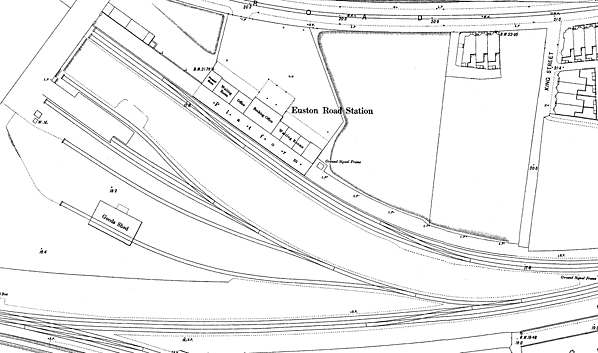
1891 OS 1:500 Town Plan. Although this Town Plan is dated 1891 this is the publication date, but the survey was earlier as it shows the station as built with only one platform. The two buildings at the north end of the platform are the gents' and ladies’ toilets; an unusually large block to cater for the huge numbers passing through the station during a summer weekend. The rooms in the main station building are, from left to right, porters' room, waiting room, office, booking office and four waiting rooms. At this time the station had no signal box,with points being controlled from a ground frame at the east end of the station building. The goods yard has five sidings serving a cattle dock near the entrance to the yard with a weighbridge alongside. The southern siding passes thorough a large goods shed.
Click here to see a larger version. 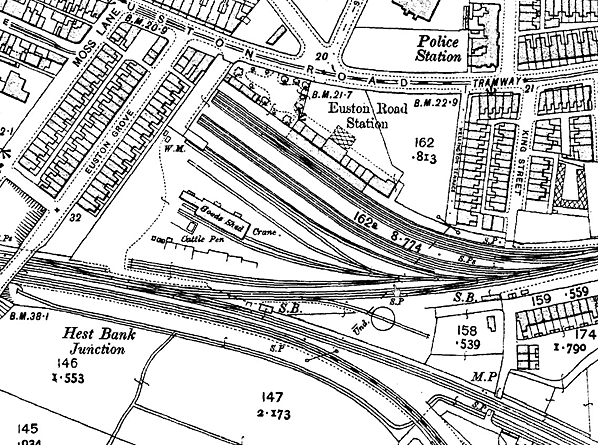
By 1891 the excursion platforms at Morecambe LNWR station had been added, as shown on this 1:2,500 OS map from that year. The excursion platforms never had any buildings. They were built on the site of the former cattle dock. A new smaller dock has now been provided alongside the goods shed with an additional siding passing to one side. Extensive cattle pens are seen close by. There are two further sidings between the pens and the main line with a turntable between the LNWR and Midland lines. Two signal boxes have now been provided: Morecambe Euston Road Box (An LNWR Type 4) controlled access to the station and goods yard, and the other was between the LNWR and Midland lines at Hest Bank Junction. The original goods shed has been replaced with a new building and a 4-ton capacity crane stands at the east end.
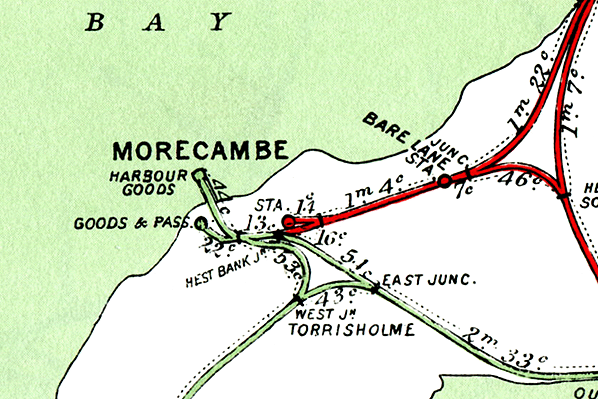
A Railway Clearing House map from 1915 showing the railways at Morecambe. The LNWR line is shown coloured red and the MR as green.
euston_road_old3.jpg) Looking north-west along platform 2 at Morecambe Euston Road station in the early 1900s. A train has just arrived and hundreds of holidaymakers are seen heading for the station exit. At this time the station was simply Morecambe and was known locally as the LNWR station. The two excursion platforms were devoid of any buildings.
Copyright photo from John Alsop collection euston_road_old4.jpg)
A view looking north-east towards Morecambe Euston Road stations platforms 2 and 3 from platform 4 in the early 1900s. A train carrying a large number of passengers has just arrived.
Copyright photo from John Alsop collection euston_road_old1.jpg)
A busy scene at Morecambe Euston Road station in the first decade of the twentieth century. Day trippers are seen heading back to their trains on one of the island platforms. To the left is the large toilet block at the west end of platform 1.
Photo from John Mann collection euston_road_old5.jpg)
Morecambe Euston Road’s spacious forecourt looking south in the early years of the twentieth century. The large glass-and-iron porte cochère allowed carriages to drive under cover to protect their passengers from the weather.
Copyright photo from John Alsop collection euston_road_old6.jpg) Looking south-east along platform 2 at Morecambe Euston Road station in the 1930s.
Copyright photo from John Alsop collection euston_road_old7.jpg)
Morecambe Euston Road station looking south in the 1930s. Motor coaches and taxis are seen waiting for the arrival of the next train.
Copyright photo from John Alsop collection
euston_road_old2.jpg)
Looking north-west along Morecambe Euston Road's island platform 2 and 3 in the late 1950s. Standing at platform 3 is a Derby lightweight DMU on a holiday working.
Photo from John Mann collection euston_road_old14.jpg)
A Class 108 Derby-built DMU is seen at Morecambe Euston Road platform 3 in July 1961. The DMU was being shunted in preparation for its next turn on a special working.
Photo by Ron Herbert euston_road_old29.jpg) Ex-LMS 4-6-0 locomotive No.45669 is seen passing Morecambe Euston Road station en route from Morecambe Promenade to Carnforth for servicing in July 1961. This loco was built at Crewe in 1935, entering service on the 4 December. A Stanier-designed Jubilee, it carried the name 'Fisher' and was withdrawn on 1 June 1963 from 2B Nuneaton shed and scrapped by BR at Crewe during July of the same year. The Jubilee class locos were designed for main line passenger work;
four have survived into preservation. Photo by Ron Herbert
|
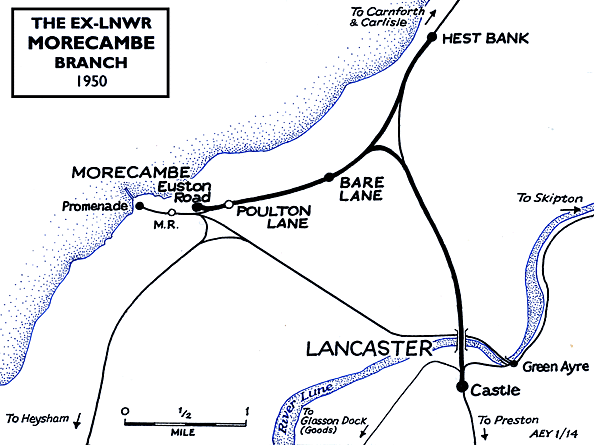
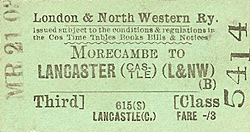 The station was located on the south side of Euston Road on the eastern edge of the town. The main entrance was set back from the road and in front of it there was a large square. Facing the square the station was a lengthy, symmetrical structure, with a two-storey central block flanked by sprawling single-storey wings ending in pavilions. The central block had a hipped, slate roof and the remainder was ridged. Biddle (1973) is less than complimentary in his description of the building: he notes that ‘it was typical of the London & North Western’s ideas of going to town – a long vivid yellow-brick façade, which must have been quite startling when it was new, with a large glass-and-iron porte cochère, repeated on the platform side as an awning. It was a fairly gross piece of work, only the iron cresting and brackets displaying any delicacy’. The upper floor of the central block was distinguished by three cross-gables, the middle being slightly taller and having paired windows while its neighbours had only one. The composition was dominated by numerous segmental-arched openings, culminating with a flourish in the end pavilions where they were arranged in Venetian style. In the central block was the booking hall and flanking it were waiting rooms and an office. At the western end there was a refreshment room.
The station was located on the south side of Euston Road on the eastern edge of the town. The main entrance was set back from the road and in front of it there was a large square. Facing the square the station was a lengthy, symmetrical structure, with a two-storey central block flanked by sprawling single-storey wings ending in pavilions. The central block had a hipped, slate roof and the remainder was ridged. Biddle (1973) is less than complimentary in his description of the building: he notes that ‘it was typical of the London & North Western’s ideas of going to town – a long vivid yellow-brick façade, which must have been quite startling when it was new, with a large glass-and-iron porte cochère, repeated on the platform side as an awning. It was a fairly gross piece of work, only the iron cresting and brackets displaying any delicacy’. The upper floor of the central block was distinguished by three cross-gables, the middle being slightly taller and having paired windows while its neighbours had only one. The composition was dominated by numerous segmental-arched openings, culminating with a flourish in the end pavilions where they were arranged in Venetian style. In the central block was the booking hall and flanking it were waiting rooms and an office. At the western end there was a refreshment room. 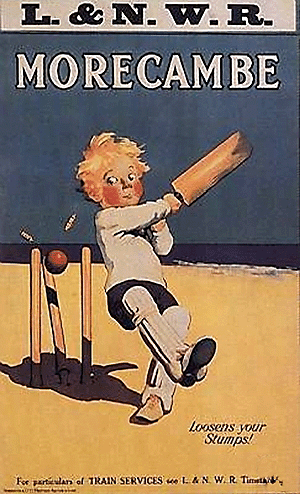 The station had one long platform used by arrivals and departures. A canopy extended from the building and covered the width of the platform. At the eastern end of the building a ground frame controlled the points and signals at the station. At the western end of the platform was a separate building that contained toilets for both sexes.
The station had one long platform used by arrivals and departures. A canopy extended from the building and covered the width of the platform. At the eastern end of the building a ground frame controlled the points and signals at the station. At the western end of the platform was a separate building that contained toilets for both sexes. 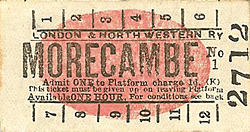 By the late 1920s Morecambe was being visited by hundreds of thousands of people every year, mostly during the summer months. The LMS summer timetable for 1932 showed Euston Road being served by trains from destinations as far away as Barrow, Crewe, Lake Side (Windermere), London Euston and Manchester Victoria. There was also a frequent service to and from Lancaster Castle.
By the late 1920s Morecambe was being visited by hundreds of thousands of people every year, mostly during the summer months. The LMS summer timetable for 1932 showed Euston Road being served by trains from destinations as far away as Barrow, Crewe, Lake Side (Windermere), London Euston and Manchester Victoria. There was also a frequent service to and from Lancaster Castle. 
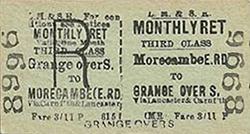 In 1959 Mr Arthur Herbert became stationmaster at Euston Road having previously held the same post at Bare Lane. Mr Herbert involved his family in the running of the station during the summer months his daughter Pat Herbert having a Saturday job as a train announcer. On Saturday 8 August 1959 Pat Herbert was on duty and she kept the sheets from which she read out the train information. There were 23 departures and 26 arrivals at Morecambe Euston Road. Departing trains ran to destinations including Birmingham New Street, Glasgow Central, Kendal, Lancaster, Manchester Exchange, Manchester Victoria, Millom, Preston, Stockport Edgeley, Uttoxeter and Windermere.
In 1959 Mr Arthur Herbert became stationmaster at Euston Road having previously held the same post at Bare Lane. Mr Herbert involved his family in the running of the station during the summer months his daughter Pat Herbert having a Saturday job as a train announcer. On Saturday 8 August 1959 Pat Herbert was on duty and she kept the sheets from which she read out the train information. There were 23 departures and 26 arrivals at Morecambe Euston Road. Departing trains ran to destinations including Birmingham New Street, Glasgow Central, Kendal, Lancaster, Manchester Exchange, Manchester Victoria, Millom, Preston, Stockport Edgeley, Uttoxeter and Windermere. 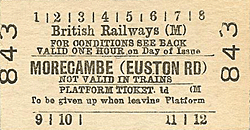 In 1965 BR obtained an act to build a new railway from a point just to the east of the station to the former MR Heysham branch. The purpose of the new line was to allow the complete closure of the MR line between Lancaster and Morecambe but allow trains to run to Heysham without having to perform a reversal at Morecambe Promenade. Under the plan Morecambe Promenade station was to close and Morecambe Euston Road would have become the terminus for passenger trains. The new line required the demolition of some houses and was widely reported in the local media.
In 1965 BR obtained an act to build a new railway from a point just to the east of the station to the former MR Heysham branch. The purpose of the new line was to allow the complete closure of the MR line between Lancaster and Morecambe but allow trains to run to Heysham without having to perform a reversal at Morecambe Promenade. Under the plan Morecambe Promenade station was to close and Morecambe Euston Road would have become the terminus for passenger trains. The new line required the demolition of some houses and was widely reported in the local media. 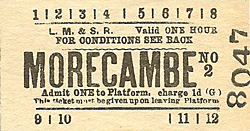
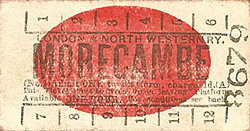

 Home Page
Home Page